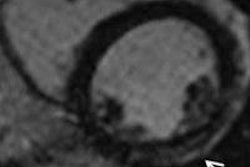
Is cardiovascular MR better than SPECT for imaging of ischemia? That was the burning question in a debate at this week's annual meeting of the European Society of Cardiology (ESC) in Barcelona, Spain, but the answer still eludes experts, it seems.
In terms of accuracy, clinical impact, and safety, cardiovascular MR (CMR) has important advantages, according to Dr. Sven Plein, PhD, professor of cardiology, a British Heart Foundation senior clinical research fellow and honorary consultant cardiologist at the Leeds Institute of Cardiovascular and Metabolic Medicine.
 Cardiac MR is better than SPECT Dr. Sven Plein, PhD, told ESC delegates. Image courtesy of the European Society of Cardiology (ESC).
Cardiac MR is better than SPECT Dr. Sven Plein, PhD, told ESC delegates. Image courtesy of the European Society of Cardiology (ESC)."It appears certainly in the data that I have presented to be the best test for ischemia because it has the ability to detect subendocardial ischemia better than SPECT due to its better resolution," said Plein, who is vice chairman of the ESC's Working Group on Cardiovascular MR and a board member of the Society for Cardiovascular MR.
The use of cardiac MR is still used a lot less around the globe than SPECT, but the time has now come to think about introducing it in more institutions where local expertise is available, he recommends. CMR's basic principles are more suited for ischemia detection, and it has higher diagnostic accuracy and stronger prognostic value. Additionally, it is better at predicting other relevant pathology such as infarction and myocarditis and is safer, especially in patients at higher risk from exposure to ionizing radiation.
Plein, who wrote the ESC's 2010 guidelines for training in CMR, thinks quality control and training will be major challenges in the years to come. He is chair of the education committee of the EuroCMR working group, set the European CMR accreditation examination, and lectures on the official ESC-endorsed CMR training course, in addition to the biannual CMR course in Leeds.
His own research is focused on developing MRI methods for the assessment of ischemic heart disease and heart failure, and his group has developed methods for myocardial perfusion and coronary MRI. In clinical applications, these and other methods are being applied to patients with acute and stable coronary symptoms and various etiologies of heart failure.
Why you can't beat SPECT
Speaking against the motion was Dr. Philipp A. Kaufmann, chief of cardiac imaging and professor of nuclear medicine at Zurich University Hospital.
"Is CMR superior to SPECT? For the detection of heart disease, I believe yes, but for the detection of ischemia, I'm not convinced," said Kaufmann, adding that he favors combining the technologies by using PET/MR and MR/CT. "If you can't beat them, then join them!"
There has been an ongoing debate within the ESC over this topic, and the subtle change of approach at previous congresses is quite revealing, he explained. For instance, at ESC 2011, the question asked was, "Has CMR replaced nuclear imaging?" and at ESC 2012, it was "Can CMR replace nuclear imaging?" At last year's meeting, three main queries were addressed: "Should CMR replace nuclear imaging? Why hasn't CMR replaced nuclear imaging? Will CMR replace nuclear imaging?"
Quoting from the Wikipedia entry about CMR's risks, he noted the technique can have genotoxic effects in vivo, and both the prudent use of CMR and further studies are necessary, according to the precautionary principle. Although nonionizing radiation is generally considered to be safe, radiofrequency fields used in CMR are possible class IIb carcinogens, according to the International Agency of Research on Cancer, and the World Health Organization (WHO) has urgently called for action to evaluate adverse biological effects of clinical MRI, which can produce detectable damage to human lymphocyte DNA integrity.
"It has a certain risk," Kaufmann pointed out. "In order to defend your patient's interest, you should use the best technique, even if it's not yours. Accept that data does not support the superiority of CMR ischemia scan, and finally as you can't beat SPECT, use SPECT!"
His research interests include noninvasive cardiac imaging, new algorithms for assessing coronary artery disease, and plaque characterization. A particular strength of the Zurich facility is hybrid imaging, combining CT for the coronary arteries with perfusion studies using myocardial scintigraphy or PET.
Given the evenly split audience vote, the debate looks set to continue over the years to come.



















